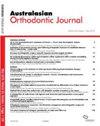矫正器治疗:患者体验及影响因素
IF 0.9
4区 医学
Q4 DENTISTRY, ORAL SURGERY & MEDICINE
引用次数: 0
摘要
【摘要】目的了解患者对矫正器治疗的体验及相关影响因素。方法采用美国加州Align Technology公司的Invisalign牙齿矫正器,将102例患者分为初始治疗组(62例)和改良组(40例)。收集临床诊断和治疗方案。在开始(第0天,佩戴第一套矫正器前)和佩戴第一套矫正器后的前7天(第1-7天)记录视觉模拟量表(VAS)、焦虑自评量表(SAS)和口腔健康影响量表-14 (o髋关节-14)的数据。结果患者在矫正器治疗前2天疼痛、焦虑和生活质量最差(P < 0.05), 1周内恢复正常。初始阶段患者经验水平高于后期细化阶段(P < 0.01)。在初始治疗期间,所研究的因素对疼痛(VAS)水平(均P > 0.05)和焦虑(SAS)水平(均P > 0.10)均无显著影响;优化附着体牙数对生活质量有显著影响(R = 0.28, P = 0.03)。在细化阶段,研究因素对疼痛(VAS)水平无显著影响(P < 0.05);矫正器组数显著影响焦虑水平(SAS) (R = 0.41, P < 0.01);治疗复杂性、结局和需要指数(ICON) (R = 0.44, P < 0.01)和是否需要弹性治疗对生活质量有显著影响(OHIP-14) (R = 0.349, P = 0.03)。结论患者对矫正器治疗的体验在前两天最差,一周后有所改善。患者在初始阶段的体验通常比细化阶段差。发现有四个临床因素有影响,包括优化附着物的牙齿数量,校准器组的数量,ICON和对弹性的需求。本文章由计算机程序翻译,如有差异,请以英文原文为准。
Aligner treatment: patient experience and influencing factors
Abstract Objectives To investigate patient experience of aligner treatment and associated influencing factors. Methods A total of 102 patients wearing Invisalign clear aligners (Align Technology, California, USA) were recruited in an initial treatment group (N = 62) and a refinement group (N = 40). Clinical diagnoses and treatment designs were collected. Data from a Visual Analogue Scale (VAS), a Self-Rating Anxiety Scale (SAS), and an Oral Health Impact Profile-14 (OHIP-14) were recorded at the commencement (Day 0, before wearing the first set of aligners) and during the first 7 days (Days 1–7) after wearing the first set of aligners. Results The patient experience of aligner treatment (i.e., pain, anxiety and quality of life) was poorest during the first two days (P < 0.05), and returned to a normal level within a week. The level of patient experience during the initial phase was greater than that during the later refinement phase (P < 0.01). During the initial treatment, the studied factors did not significantly influence the level of pain (VAS) (P > 0.05 for all) nor anxiety (SAS) (P > 0.10 for all); the number of teeth with optimised attachments significantly (R = 0.28, P = 0.03) influenced the quality of life (OHIP-14). During the refinement phase, the studied factors did not significantly influence the level of pain (VAS) (P > 0.09 for all); the number of aligner sets significantly influenced the level of anxiety (SAS) (R = 0.41, P < 0.01); the Index of Treatment Complexity Outcome and Need (ICON) (R = 0.44, P < 0.01) and whether elastics were required significantly influenced the quality of life (OHIP-14) (R = 0.349, P = 0.03). Conclusions Patient experience of aligner treatment was poorest during the first two days and improved over a week. Patient experience during the initial phase was generally worse than that during refinement. Four clinical factors were found to have an influence, including the number of teeth with optimised attachments, the number of aligner sets, the ICON, and the need for elastics.
求助全文
通过发布文献求助,成功后即可免费获取论文全文。
去求助
来源期刊

Australasian Orthodontic Journal
Dentistry-Orthodontics
CiteScore
0.80
自引率
25.00%
发文量
24
期刊介绍:
The Australasian Orthodontic Journal (AOJ) is the official scientific publication of the Australian Society of Orthodontists.
Previously titled the Australian Orthodontic Journal, the name of the publication was changed in 2017 to provide the region with additional representation because of a substantial increase in the number of submitted overseas'' manuscripts. The volume and issue numbers continue in sequence and only the ISSN numbers have been updated.
The AOJ publishes original research papers, clinical reports, book reviews, abstracts from other journals, and other material which is of interest to orthodontists and is in the interest of their continuing education. It is published twice a year in November and May.
The AOJ is indexed and abstracted by Science Citation Index Expanded (SciSearch) and Journal Citation Reports/Science Edition.
 求助内容:
求助内容: 应助结果提醒方式:
应助结果提醒方式:


